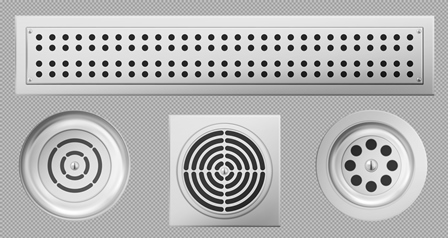A bathroom exhaust fan damper flap plays an essential role in maintaining the efficiency of your ventilation system. Whether you’re installing a new system or maintaining an existing one, understanding how the damper flap works is key to ensuring optimal air circulation, energy efficiency, and moisture control within your home. The B2425 3-inch bathroom exhaust fan damper flap is designed to prevent backflow, improve air quality, and regulate ventilation.
What Is a Bathroom Exhaust Fan Damper Flap?
The damper flap is a critical part of any ventilation system. It functions as a one-way valve for air movement. When the bathroom exhaust fan is in use, the flap opens, allowing moist and stale air to exit through the ventilation duct. When the fan is not in use, the damper closes, preventing outside air or debris from entering the duct system. This helps maintain the air quality inside your bathroom and prevents drafts from cooling down the space.
Key Features of the B2425 3-Inch Damper Flap
The B2425 3-inch damper flap is known for its durability and compatibility with most standard 3-inch duct systems. Below are some of its key features that make it a preferred choice for homeowners and contractors alike:
- Material Composition: The B2425 damper flap is typically made from high-quality galvanized steel or durable plastic, offering excellent resistance to rust and corrosion.
- Size: Designed to fit into a 3-inch duct, this damper is ideal for small to medium-sized bathrooms.
- Easy Installation: With its universal design, the B2425 is easy to install without requiring specialized tools.
- Backdraft Protection: The flap ensures that no air backflows into your bathroom, maintaining the efficiency of your ventilation system and contributing to better indoor air quality.
- Energy Efficiency: By preventing drafts and maintaining proper air sealing, the damper helps reduce heating and cooling costs in your home.
Why Is the Damper Flap Important?
When it comes to bathroom ventilation, having a properly functioning damper flap is non-negotiable. Here are some reasons why the damper flap is so important:
Moisture Control:
Bathrooms are prone to high levels of moisture, especially after showers or baths. A functioning exhaust fan paired with an efficient damper flap can expel this moisture, preventing mold, mildew, and other forms of water damage from occurring.
Improved Indoor Air Quality:
A damper flap prevents contaminated air from re-entering your home, which helps to maintain healthier air quality in your living spaces.
Energy Savings:
When the damper flap is closed, it acts as a barrier against outside air, preventing unwanted drafts that could affect the temperature inside your home. This ultimately leads to lower energy consumption for heating and cooling.
How to Install the B2425 3-Inch Bathroom Exhaust Fan Damper Flap
Installing a bathroom exhaust fan damper flap like the B2425 3-inch model is a relatively straightforward process, but attention to detail is essential to ensure proper performance. Here is a step-by-step guide to help you through the installation process:
Tools and Materials You’ll Need:
- B2425 3-inch damper flap
- Screwdriver or drill
- Metal tape or clamps
- Ventilation duct
- Ladder (if necessary)
Step-by-Step Installation Guide:
- Turn Off Power:
Before starting, ensure the power to your bathroom exhaust fan is switched off to avoid any electrical hazards.
- Locate the Exhaust Vent:
Identify the location where the exhaust fan connects to the ductwork. This is typically in the attic or outside wall.
- Remove the Old Damper (if applicable):
If you’re replacing an old damper, carefully remove it by unscrewing or unclipping it from the duct.
- Install the B2425 Damper Flap:
Fit the B2425 damper flap into the 3-inch duct opening. Ensure the flap is correctly oriented, allowing it to open in the direction of the airflow.
- Secure the Damper:
Use metal tape or clamps to securely attach the damper to the duct. Ensure there are no gaps or loose fittings that could affect its performance.
- Test the Damper:
After installation, turn the power back on and test the exhaust fan to ensure the damper flap opens and closes as it should.
Signs That Your Bathroom Exhaust Fan Damper Flap Needs Replacing
Like any other component of your ventilation system, the damper flap will eventually wear out and require replacement. Here are some common signs that it may be time to replace your damper flap:
- Increased Drafts: If you start to notice cold drafts in your bathroom, this could indicate that the damper flap is not closing properly.
- Noisy Operation: A rattling or banging noise from the exhaust fan could suggest that the damper flap is loose or malfunctioning.
- Backdrafting: If air from outside is coming into your bathroom when the fan is not in use, it’s likely that the damper flap is not sealing correctly.
- Visible Damage: Inspect the damper for cracks, rust, or other physical damage that could impact its performance.
How to Maintain Your Bathroom Exhaust Fan Damper Flap
To ensure the longevity and efficiency of your B2425 damper flap, regular maintenance is recommended. Here’s what you should do:
- Regular Inspections:
Every few months, check the damper for signs of wear and tear. Look for debris that may block the flap from closing properly.
- Clean the Ventilation Duct:
Ensure the duct is clean and free of any obstructions. A clogged duct can prevent the damper from opening fully, reducing the effectiveness of your exhaust system.
- Lubrication:
Depending on the material of the damper flap, you may need to apply a small amount of lubricant to ensure smooth operation.
Choosing the Right Damper Flap for Your Bathroom Exhaust Fan
| Feature | B2425 3-Inch Damper Flap | Other Damper Flaps |
|---|---|---|
| Size Compatibility | Fits standard 3-inch ducts | Available in various sizes (4-inch, 6-inch, etc.) |
| Material | Galvanized steel or durable plastic | Can be plastic, aluminum, or stainless steel |
| Corrosion Resistance | High, especially in galvanized steel models | Varies depending on material (plastic is more corrosion-resistant) |
| Ease of Installation | Easy to install, no special tools required | Installation difficulty can vary by model and size |
| Backdraft Protection | Excellent backdraft prevention | Varies based on design and quality |
| Energy Efficiency | Prevents drafts and improves energy savings | Dependent on sealing quality and material |
| Durability | Long-lasting, especially in harsh conditions | Durability depends on material; metal is more durable than plastic |
| Cost | Moderate price for high-quality components | Varies widely depending on material and size |
| Ideal For | Small to medium-sized bathrooms | Different models for various room sizes and fan capacities |
Troubleshooting Common Issues
Damper Flap Not Closing Properly
One of the most common issues with a damper flap is that it may not close fully, leading to unwanted air entering your bathroom or a reduction in energy efficiency. This issue can be caused by debris blocking the flap, misalignment, or wear and tear on the damper mechanism.
Troubleshooting Steps:
- Check for Obstructions:
Inspect the damper flap for any debris or dirt that might be preventing it from closing properly. This could include dust, insects, or small particles from the ductwork. Clean the damper using a soft cloth or brush.
- Check the Alignment:
Sometimes the damper flap may become misaligned, preventing it from sealing properly. Manually move the flap to ensure that it opens and closes smoothly. If it’s off track, gently adjust it until it aligns with the duct opening.
- Examine for Damage:
Look for signs of wear, such as cracks, warping, or bent edges. If the damper is damaged, it may not close properly, and replacement may be necessary.
Damper Flap Stuck Open
When the damper flap gets stuck in the open position, outside air can enter your bathroom, causing drafts and increasing your heating or cooling costs. This problem can be due to rust, dirt, or mechanical failure within the damper system.
Troubleshooting Steps:
- Inspect for Rust or Corrosion:
If your damper is made of metal, rust or corrosion may prevent the flap from moving freely. In this case, you can try cleaning the rust off with a steel brush or using a lubricant designed for metal components. If the rust is extensive, replacing the damper might be necessary.
- Clean the Flap and Duct:
Dust, grime, and other buildups inside the duct can cause the flap to stick. Clean both the damper and surrounding duct area thoroughly. This may restore full movement.
- Test the Damper Movement:
After cleaning, manually move the damper flap to ensure it opens and closes smoothly. If it remains stuck, the spring mechanism or hinge might be faulty, requiring a replacement.
Noisy Damper Operation
A noisy damper flap can be an annoying issue that usually stems from loose fittings, a misaligned damper, or the flap hitting other parts of the exhaust system. The noise can range from rattling to banging, particularly when the fan is in operation.
Troubleshooting Steps:
- Tighten Loose Components:
Check if any screws or clamps securing the damper flap to the ductwork are loose. Tighten them to ensure the damper is securely in place.
- Inspect the Hinge or Spring:
Damaged or misaligned hinges or springs can cause the damper to make noise as it moves. Lubricate the hinges to reduce friction and adjust any parts that appear misaligned.
- Add Foam Padding:
In some cases, adding a small piece of foam or felt padding where the damper flap contacts the duct can reduce noise caused by metal-on-metal contact.
Conclusion
A bathroom exhaust fan damper flap, such as the B2425 3-inch model, is a small but essential component in maintaining an efficient and effective bathroom ventilation system. By preventing backdrafts, improving air quality, and reducing energy costs, the damper flap plays a vital role in the overall performance of your exhaust fan.
Whether you’re looking to install a new damper flap or replace an old one, the B2425 is a reliable choice that delivers excellent performance and longevity. By following proper installation and maintenance practices, you can ensure your bathroom remains well-ventilated and free of excess moisture for years to come.





